
How Many Deaf People Are in the US in 2025
If you’re wondering how many deaf people are in the US, recent data from the American Community Survey reports that about 3.6% of people in the country—almost 11 million individuals—say they are deaf or have significant difficulty hearing. According to the National Institute on Deafness and Other Communication Disorders, around 1 million Americans are considered functionally deaf. So, if you’re asking how many deaf people are in the US, these statistics provide a clear answer.
| Statistic | Estimated Number (2025) |
|---|---|
| Total with hearing loss | 11 million |
| Functionally deaf | 1 million |
| Adults reporting trouble hearing | 37.5 million |
| Children born with hearing loss | 2–3 per 1,000 |
Key Takeaways
- About 11 million people in the US have hearing loss. Around 1 million people are functionally deaf. This means they cannot understand speech, even with hearing aids. Hearing loss happens more in older adults. Half of the people with hearing loss are 65 or older. But children and young people can also have hearing problems. American Sign Language (ASL) is used by about 408,000 people in the US. This includes deaf people and hearing family members. Hearing loss can be mild or very bad. Most people have mild or moderate hearing loss. People with severe hearing loss need special help. They may use hearing aids or sign language. Early help and tools like hearing aids, cochlear implants, and sign language are important. These things help deaf people live better lives. They also help people communicate better.
How Many Deaf People Are in the US
Total with Hearing Loss
Many people in the United States have hearing loss. Two big surveys collect this information. These are the American Community Survey and the Survey of Income and Program Participation. They say about 11 million people in the country have some hearing loss. This group includes both adults and children who have trouble hearing every day.
Older adults have hearing loss more often than younger people. More than half of people with hearing loss are 65 or older. Less than 4% of people with hearing loss are under 18. The Centers for Disease Control and Prevention says about 14.4% of adults call themselves Deaf or Hard of Hearing.
Here is a table that shows hearing loss in different age groups:
| Population Group | Percentage with Hearing Loss |
|---|---|
| American adults aged 18 and over | Approximately 15% |
| Adults aged 45-54 years | About 2% |
| Adults aged 55-64 years | 8.5% |
| Adults aged 65-74 years | 25% |
| Adults aged 75 years and older | About 50% |
| Total U.S. population (2022) | 3.7% (over 12 million) |
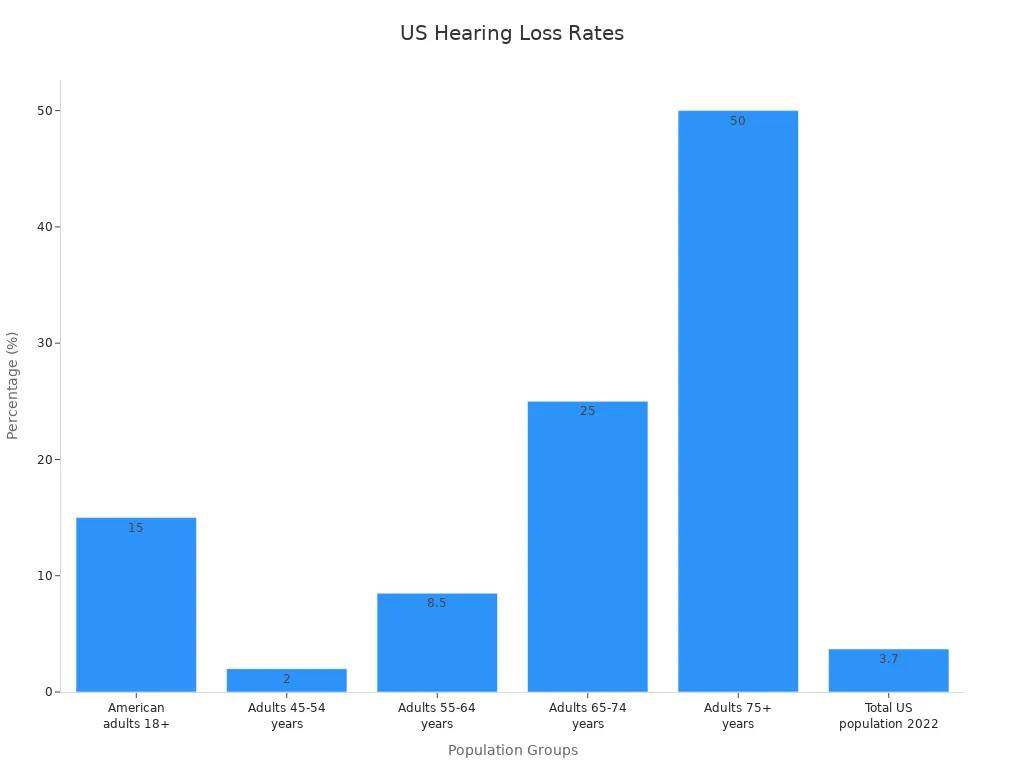
These facts help answer how many deaf people are in the US. The answer changes based on how hearing loss is defined. But millions of people deal with hearing problems every day.
Functionally Deaf
Not all people with hearing loss are functionally deaf. Functionally deaf people cannot understand speech, even with hearing aids. New studies say about 1 million people in the US are functionally deaf. These people use visual ways to talk, like sign language, lip reading, or writing notes.
Most functionally deaf people are older adults. Over half are older than 65. Children are a small part of this group. Less than 4% of functionally deaf people are under 18. These numbers show that age is important in severe hearing loss.
When people ask how many deaf people are in the US, they often mean functionally deaf people. The answer is about 1 million, based on new surveys.
ASL Users
American Sign Language is the main language for many in the Deaf community. ASL users are a special group with their own culture and language. About 408,000 people in the US use ASL as their main language at home. This number includes Deaf people and hearing family members who use ASL.
ASL users are a small but important part of people with hearing loss. Not everyone with hearing loss uses sign language. Many older adults with hearing loss use spoken language and do not learn ASL. The Deaf community sees ASL as important for culture and identity.
Note: The number of ASL users is not the same as the total number of Deaf people. Some Deaf people use other ways to communicate. Some people who use ASL are not Deaf.
Demographic Breakdown
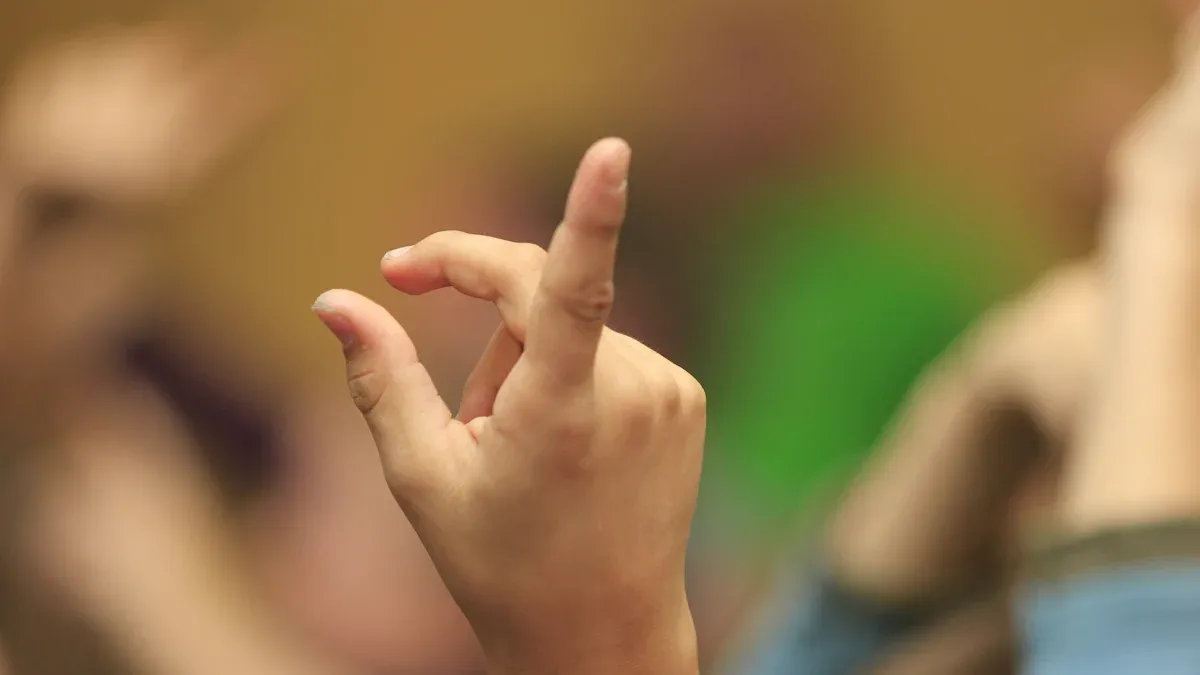
By Age
Age is important for hearing loss in the US. Kids and teens from 6 to 19 years old have about 11% with hearing loss. So, hearing loss is not just for older people. But, the chance of hearing loss goes up as people get older. For adults, 13% say they have some trouble hearing. About 1.6% say they have a lot of trouble or cannot hear at all. Both men and women have more hearing problems as they age. But men usually have higher rates than women. More people use hearing aids as they get older, especially after age 65.
| Age Group | Sex | Some Difficulty Hearing | A Lot or Cannot Hear | Hearing Aid Use |
|---|---|---|---|---|
| 6–19 yrs | N/A | ~11% | N/A | N/A |
| 18+ yrs | N/A | 13.0% | 1.6% | N/A |
| 45–64 yrs | Men | 16.7% | 1.8% | 2.8% |
| 45–64 yrs | Women | 10.6% | 1.1% | 1.9% |
| 65+ yrs | Men | 30.9% | 5.0% | 19.2% |
| 65+ yrs | Women | 23.5% | 3.3% | 10.6% |
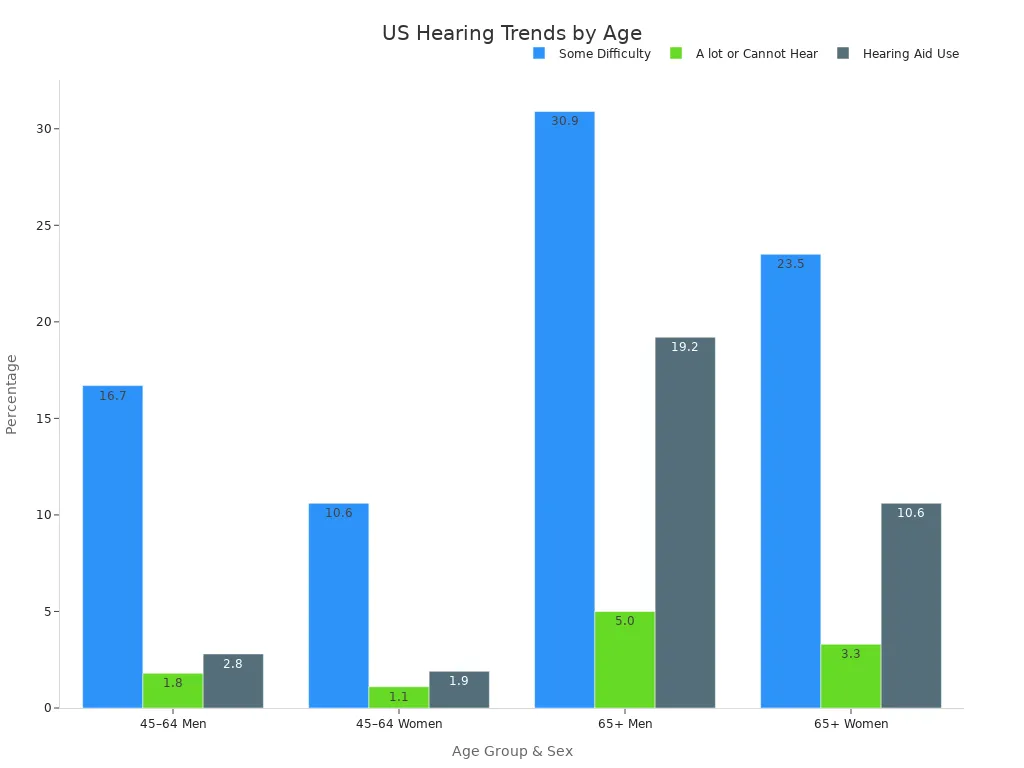
By Gender and Ethnicity
Men are a bigger part of the deaf and hard-of-hearing group than women. About 57% of this group are men. In the whole country, men are about 49%. There are also differences by race and ethnicity. Most deaf adults are White, about 82.7%. Black people are 3.6%, Native American or Alaskan Native are 1.8%, and Asian people are 1.8%. People with more than one race are 4.6%. Hispanic or Latinx people are 5.5% of deaf adults. These facts show the deaf community has many kinds of people. But some groups have fewer people than in the whole country.
By Region
Where people live changes how many are deaf or hard of hearing. Rochester, New York, has one of the biggest groups. About 40,000 out of 1,155,000 people there say they are deaf or hard of hearing. Across the country, about 3.6% of people have some hearing trouble. The number of American Sign Language users in the US is between 250,000 and over 500,000. This group has its own culture. When asking how many deaf people are in the US, it is good to think about these differences in places and culture.
Severity of Hearing Loss

Mild to Severe
Hearing loss can be mild or very serious. Doctors use decibels, or dB, to measure it. A bigger number means worse hearing loss. People with mild hearing loss might not hear soft sounds. People with severe or profound loss cannot hear loud sounds at all.
The table below shows how experts group hearing loss by dB. It also shows how many people in the US are in each group:
| Hearing Loss Severity | Pure-Tone Average Threshold (dB) | Estimated Number of US Residents Aged 12+ (millions) | Prevalence (%) (Better Ear, Bilateral) |
|---|---|---|---|
| Mild | >25 through 40 | 25.4 | 37.10% |
| Moderate | >40 through 60 | 10.7 | 16.99% |
| Severe | >60 through 80 | 1.8 | 4.61% |
| Profound | >80 | 0.4 | 2.03% |
Doctors also check how hearing loss changes daily life. The next table explains what each level means and what help people might get:
| Grade of Hearing Impairment | Audiometric Threshold (dB HL, better ear) | Functional Performance Description | Intervention Recommendations |
|---|---|---|---|
| 0: No impairment | ≤ 25 dB | No or very slight hearing problems; able to hear whispers | None |
| 1: Slight impairment | 26–40 dB | Able to hear and repeat words spoken in normal voice at 1 meter | Counseling; hearing aids may be needed |
| 2: Moderate impairment | 41–60 dB | Able to hear and repeat words using raised voice at 1 meter | Hearing aids usually recommended |
| 3: Severe impairment | 61–80 dB | Able to hear some words when shouted into better ear | Hearing aids needed; lip-reading if no aids available |
| 4: Profound impairment including deafness | ≥ 81 dB | Unable to hear and understand even a shouted voice | Hearing aids may help; additional rehabilitation, lip-reading, and signing essential |
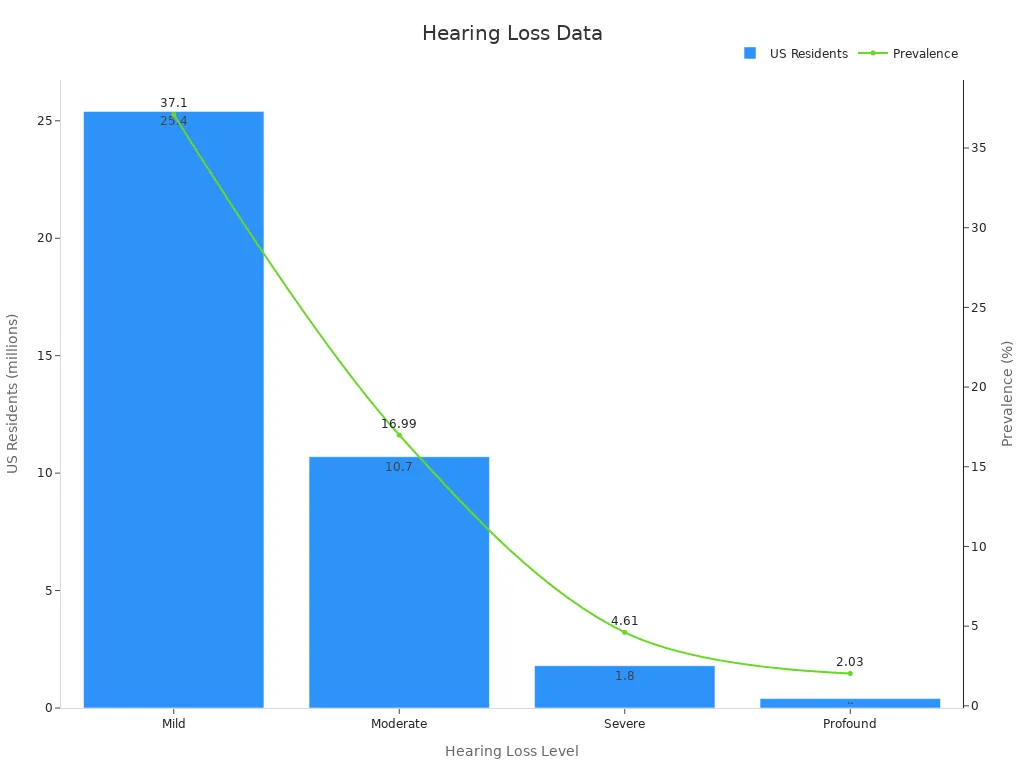
Note: Most people with hearing loss have mild or moderate cases. Only a small group has severe or profound hearing loss.
Prelingual vs. Postlingual
Doctors also talk about when hearing loss starts. Prelingual hearing loss happens before a child learns to talk. Postlingual hearing loss starts after a child can speak. Kids with prelingual hearing loss need extra help to learn language. They might use sign language or cochlear implants. Adults who lose hearing later may use lip reading, hearing aids, or write notes.
Prelingual deafness makes learning language harder for kids. Early help lets them build good communication skills. Postlingual hearing loss can make work and social life tough. But many adults learn to adjust with tools and training.
Tip: Families and teachers help kids with prelingual hearing loss do well in school and life.
Estimates & Trends
Data Sources
Researchers use trusted sources to count deaf people in the US. The American Community Survey collects hearing information every year. It started asking about hearing in 2008. The Behavioral Risk Factor Surveillance System also collects health data by phone. The National Center for Health Statistics shares hearing loss numbers too. State groups, like the Illinois Deaf and Hard of Hearing Commission, use this data for local reports.
Experts use many tools to answer how many deaf people are in the US. They mix data from the American Community Survey, NHANES, Medicare claims, and more. Small Area Estimation models help guess hearing loss in big and small places. Researchers use calibration and Bayesian models to make their numbers better. These methods help give good estimates by age, gender, and region.
Note: Using all these sources and methods helps us see hearing loss across the country.
Recent Changes
The number of people with hearing disabilities has changed over time. Since 2010, there are 17% more people reporting hearing problems. This is because people know more, the population is older, and surveys are better. Most people with hearing loss are older adults, but kids and young adults can have it too.
Prelingual deafness starts before a child learns to talk and is rare. Fewer than 1 in 1,000 people are deaf before age eighteen. Postlingual deafness happens after a child learns to speak and is more common, especially in older adults. Studies show kids who become deaf after learning language do better with cochlear implants than those deaf from birth. Both groups say their quality of life is about the same after treatment.
| Aspect | Prelingually Deafened (PRE-LG) | Postlingually Deafened (POST-LG) |
|---|---|---|
| Audiometric Outcomes | Worse than POST-LG; wide variability | Better auditory performance |
| Speech Recognition Scores (SRS) | Median ~80%; some as low as 40% | Median ~80%; generally higher |
| Quality of Life (QoL) Scores | Similar to POST-LG | Similar to PRE-LG |
| Social Indicators | 58% unmarried, 16.7% unemployed | N/A |
| CI Benefit Perception | No significant difference | No significant difference |
These trends help answer how many deaf people are in the US. Better data and new technology keep changing what we know.
Recent numbers say almost 11 million people in the US have hearing loss. About 1 million people are functionally deaf. These facts are important for families, schools, and health leaders. MarkeTrak surveys show hearing loss is going up. Mild or worse cases have grown by 77% since the 1990s.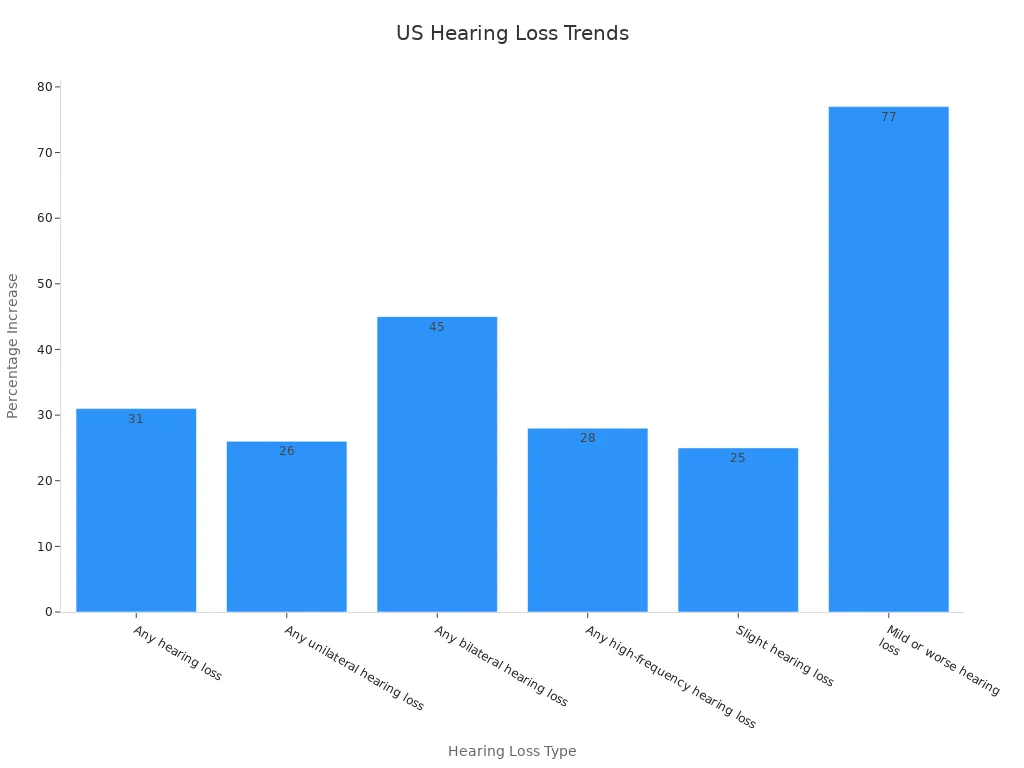
Knowing how many deaf people live in the US helps make better support and rules. For the newest news, look at trusted health sources.
FAQ
How does the government define "functionally deaf"?
The government says "functionally deaf" people cannot understand speech. This is true even if they use hearing aids. These people often use sign language to talk. Some use lip reading or write notes to share ideas.
What is the difference between hearing loss and deafness?
Hearing loss means a person has trouble hearing sounds. Deafness means a person cannot hear most sounds, even loud ones. Deaf people often use visual ways to talk with others.
How many children in the US are born with hearing loss each year?
About 2 or 3 out of every 1,000 kids are born with hearing loss in the US. Early tests help families get support fast.
Do all deaf people use American Sign Language (ASL)?
Not every deaf person uses ASL. Some use spoken words, lip reading, or other sign languages. ASL users are a special group in the deaf community.
Where can families find support for deaf children?
Families can get help from schools and local health groups. National groups like the National Association of the Deaf also help. Early support helps deaf children learn and grow.
